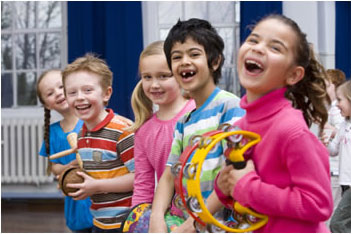The value of movement in connection with learning is unparalleled in our elementary and primary classrooms. In cultures around the world, exploration through percussion is a natural way of connecting children to the group and developing their motor responses. Movement through music, furthermore, helps stimulate the brain and integrate the right and left hemispheres
After extensive observations of how young children learn about the world by interacting with objects in their environment, physician and educator Maria Montessori once wrote,
“Not only are thought and action two parts of the same occurrence, but it is through movement that the higher life expresses itself.”
Since the action of drumming comes easily to children, exploring percussion is a way to open the door to a broader appreciation of music and achieving the benefits that music has to offer.
Here are some ways that you can introduce percussion instruments and percussive music to your students. After these starter activities, you may want to devote some time with your classes to discuss what kind of sounds were heard, what is rhythm, and how a song can be made with beats:
Play the Room – Taking caution not to strike anything that is fragile, allow children to explore the room with drumsticks. Tap the floor, tables, chairs, desks, doorknobs, and shelves. For discussion, ask what makes a loud or soft sound, and what object kept the longest sound. Have children sit in pairs, taking turns “playing the floor” and listening, to help make the connection between vibration and sound.
Create Copycat Rhythms – Clap a pattern and have students echo-clap back to you. Encourage other children to be the leader for the group “conversation.” Copycat rhythms can be created by stomping feet, jumping, or with drums or shakers in the circle. Connect rhythm to what children know by singing familiar nursery rhymes and clapping to the beat.
Play the Jungle Beat – Start with pictures of different jungle animals and talk about what kind of sound characterizes that animal. With stomping feet in hard or soft, slow and fast beats, practice together how an elephant or rhinoceros sounds. How is this different from the sound of a monkey walk, or a tiger stalking its prey?
Use Found Objects – Objects everywhere from the kitchen to the junkyard can be used to make a sound. Ask children to bring something from home that they think makes a good sound (pots and pans, lids for cymbals, graters or scrapers) and have them introduce the sound in the circle. What rattles, clatters, or jingles? Talk about the qualities of the sound, and then conduct the group in an orchestra of stuff!
Introduce Instruments that Children can Easily Play – Instruments such as the xylophone, tambourine, maracas, triangles, glockenspiels and bongo drums are ideal for their ease of play and varying percussive qualities. Allow time for children to explore the qualities of their sounds, or have a set space in class so that children try making their own music with instruments that they choose.
Listen to Great Traditions – The music of Ghana and Nigeria has particularly rich drumming traditions. Listen to recordings from Africa and other cultures to expose children to the masters of percussive rhythms.
Reading about percussion instruments and exposing our students is a first active step to introducing elementary aged children to percussion instrument playing. One way to learn more is by sharing your own ideas and strategies with the wider Fun Music Company community using the comments box below. Be sure to leave your feedback giving details of your favourite strategy for teaching percussion to elementary and primary children so you can network with other teachers and find new ideas and strategies together.
You’ll also find some tips on how to properly play some beginning percussion instruments at our percussion secrets video which is presented by an expert percussionist who makes learning percussion instruments very easy to understand. If you’re looking for something which is a hands on approach to general music percussion with elementary/ lower primary students and you have access to an interactive whiteboard, you can access a ready to go lesson and watch a video at http://funmusicco.com/interactive-whiteboard.html. Alternatively, if you would like to have more music percussion ideas for upper primary students, you might also be interested in my article called “Teaching ideas Using STOMP in a general music class” which will give you all kinds of ideas on junk percussion and other percussion instruments that will motivate mid- upper primary students.



Percussion for children is wonderful, and far more valuable then reading, writing & rithmetic.
This website is a Good sent.